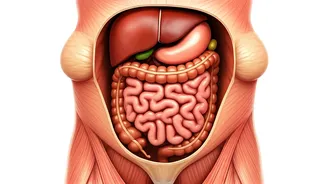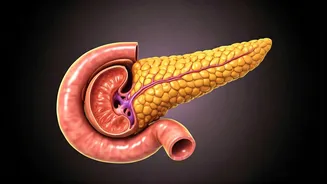Fat's Crucial Role
The study indicates that reducing belly fat is critical for preventing prediabetes, even if total body weight remains stable. Belly fat, or visceral fat, is linked
to insulin resistance and inflammation, major drivers of prediabetes. This research highlights the health implications of different types of body fat, advocating a targeted approach to weight management. Unlike subcutaneous fat, which lies beneath the skin, visceral fat wraps around internal organs and is metabolically active. This means it releases hormones and inflammatory substances that interfere with insulin's function, increasing blood sugar levels and the risk of prediabetes. Prioritizing belly fat reduction can improve insulin sensitivity and diminish the likelihood of developing this health condition. The research emphasizes that where fat accumulates matters greatly when it comes to disease risk.
Dietary Strategies
Dietary changes play a vital role in reducing belly fat and, consequently, lowering prediabetes risk. A diet abundant in whole, unprocessed foods like fruits, vegetables, and lean proteins is ideal. These foods promote weight management and reduce inflammation. Limiting sugar and refined carbohydrates is essential. Processed foods, sugary beverages, and refined grains contribute to visceral fat accumulation and should be minimized. Portion control is a powerful tool. Even when eating healthy foods, overconsumption can lead to weight gain. Eating smaller, more frequent meals can help regulate blood sugar levels and prevent overeating. Furthermore, increasing the intake of soluble fiber, found in oats, beans, and certain fruits, can slow down digestion and stabilize blood sugar. A well-planned, nutrient-rich diet forms the foundation of a strategy to combat prediabetes.
Exercise's Impact
Regular physical activity is an integral part of reducing belly fat and fighting prediabetes. Both aerobic exercises and resistance training are effective. Aerobic exercises, such as brisk walking, running, or swimming, help burn calories and reduce overall body fat. Strength training, using weights or bodyweight exercises, builds muscle mass. Muscle tissue is more metabolically active than fat, helping to increase metabolism and burn more calories, even at rest. Aim for at least 150 minutes of moderate-intensity or 75 minutes of vigorous-intensity aerobic exercise weekly, combined with strength training exercises at least twice a week. Consistent exercise improves insulin sensitivity and reduces visceral fat. Combining exercise with dietary changes can yield even better results.
Lifestyle Modifications
Beyond diet and exercise, certain lifestyle adjustments can help reduce belly fat and manage prediabetes. Stress management is essential. Chronic stress elevates cortisol levels, which can contribute to increased fat storage, particularly in the abdominal area. Practices like yoga, meditation, and deep breathing exercises can help regulate cortisol. Adequate sleep is another key factor. Sleep deprivation disrupts hormones, affecting appetite and insulin sensitivity. Aim for 7-9 hours of quality sleep each night. Furthermore, avoid smoking and limit alcohol consumption. Smoking increases the risk of weight gain and several other health problems. Excessive alcohol intake contributes to weight gain and can also worsen insulin resistance. By making these lifestyle modifications, individuals can support their efforts to reduce belly fat and enhance their overall health.












